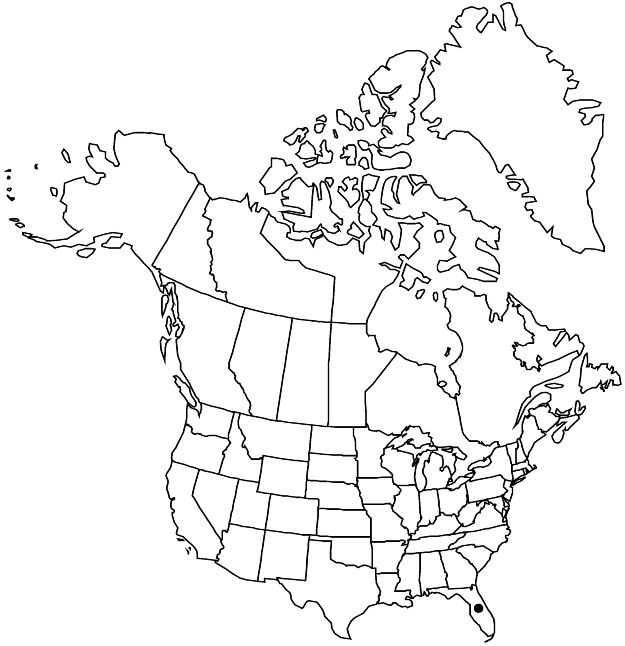Difference between revisions of "Euphorbia mendezii"
Cent. Euphorb., 15. 1860.
FNA>Volume Importer |
imported>Volume Importer |
||
| (2 intermediate revisions by 2 users not shown) | |||
| Line 35: | Line 35: | ||
|elevation=0–10 m. | |elevation=0–10 m. | ||
|distribution=Fla.;Mexico;West Indies;Central America;n South America. | |distribution=Fla.;Mexico;West Indies;Central America;n South America. | ||
| + | |introduced=true | ||
|discussion=<p><i>Euphorbia mendezii</i> is a common weed distributed widely throughout Mexico and Central America. Within the flora area the species is known only from southern Florida.</p> | |discussion=<p><i>Euphorbia mendezii</i> is a common weed distributed widely throughout Mexico and Central America. Within the flora area the species is known only from southern Florida.</p> | ||
|tables= | |tables= | ||
| Line 59: | Line 60: | ||
|publication year=1860 | |publication year=1860 | ||
|special status=Weedy;Introduced | |special status=Weedy;Introduced | ||
| − | |source xml=https:// | + | |source xml=https://bitbucket.org/aafc-mbb/fna-data-curation/src/2e0870ddd59836b60bcf96646a41e87ea5a5943a/coarse_grained_fna_xml/V12/V12_234.xml |
|genus=Euphorbia | |genus=Euphorbia | ||
|section=Euphorbia sect. Anisophyllum | |section=Euphorbia sect. Anisophyllum | ||
Latest revision as of 19:14, 5 November 2020
Herbs, annual or perennial, with slender taproot. Stems prostrate, often mat-forming, 8–35 cm, usually villous along margins, lower surface glabrous, upper surface usually strigillose to puberulent, rarely glabrous or glabrate. Leaves opposite; stipules usually distinct or connate basally, rarely completely connate, deltate, laciniate, glabrous or pilose (lower side), forming narrow deltate scale, sometimes apically 2-fid or laciniate, glabrous (upper side), 0.4–1.9 mm; petiole 0.3–1.2 mm, glabrous, pilose or villous; blade oblong to obovate, 4–12 × 2–7 mm, base asymmetric, one side attenuate, cuneate or rounded, other rounded or cordate, margins serrulate at least distally, apex obtuse, surfaces glabrous or sparsely sericeous, pilose or villous; 3-veined at base. Cyathia solitary at nodes or on short, congested axillary branches; peduncle 0.9–2.5 mm. Involucre campanulate or obconic, 0.8–1 × 0.7–0.8 mm, usually glabrous, rarely sparsely pilose toward apex; glands 4, pink, reniform, oblong or elliptic, 0.1 × 0.2–0.3 mm; appendages absent or white to pink, oblong, flabellate or forming narrow rim around edge of gland, 0.1–0.3 × 0.3–0.6 mm, distal margin usually entire, sometimes lobed. Staminate flowers 6–15. Pistillate flowers: ovary usually pilose or villous with hairs concentrated along keels, rarely glabrous; styles 0.2–0.3 mm, 2-fid 1/2 length. Capsules ovoid, 1.2–1.6 × 1.2–1.4 mm, usually pilose or villous with hairs concentrated along keels, often glabrous in between, very rarely completely glabrous; columella 1–1.4 mm. Seeds reddish brown to orange or gray-pink, narrowly ovoid, 4-angled in cross section, 0.9–1.2 × 0.5–0.6 mm, almost smooth or with 5–7 faint transverse ridges that do not pass through abaxial keel.
Phenology: Flowering and fruiting year-round.
Habitat: Disturbed areas.
Elevation: 0–10 m.
Distribution

Introduced; Fla., Mexico, West Indies, Central America, n South America.
Discussion
Euphorbia mendezii is a common weed distributed widely throughout Mexico and Central America. Within the flora area the species is known only from southern Florida.
Selected References
None.